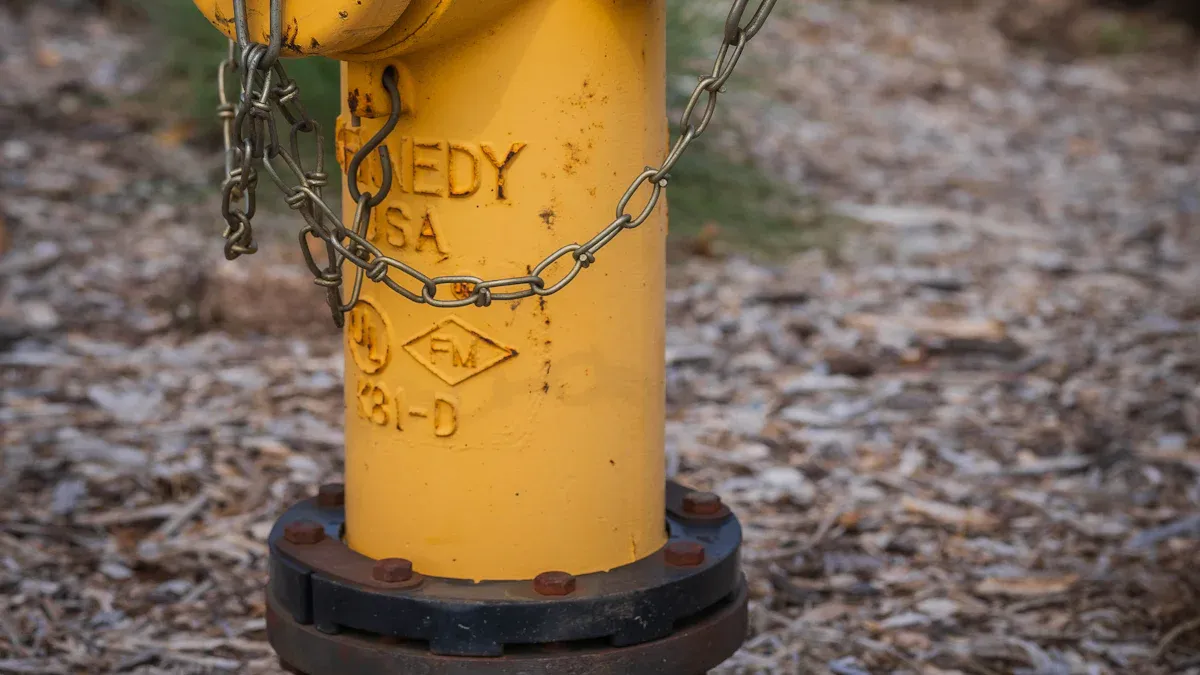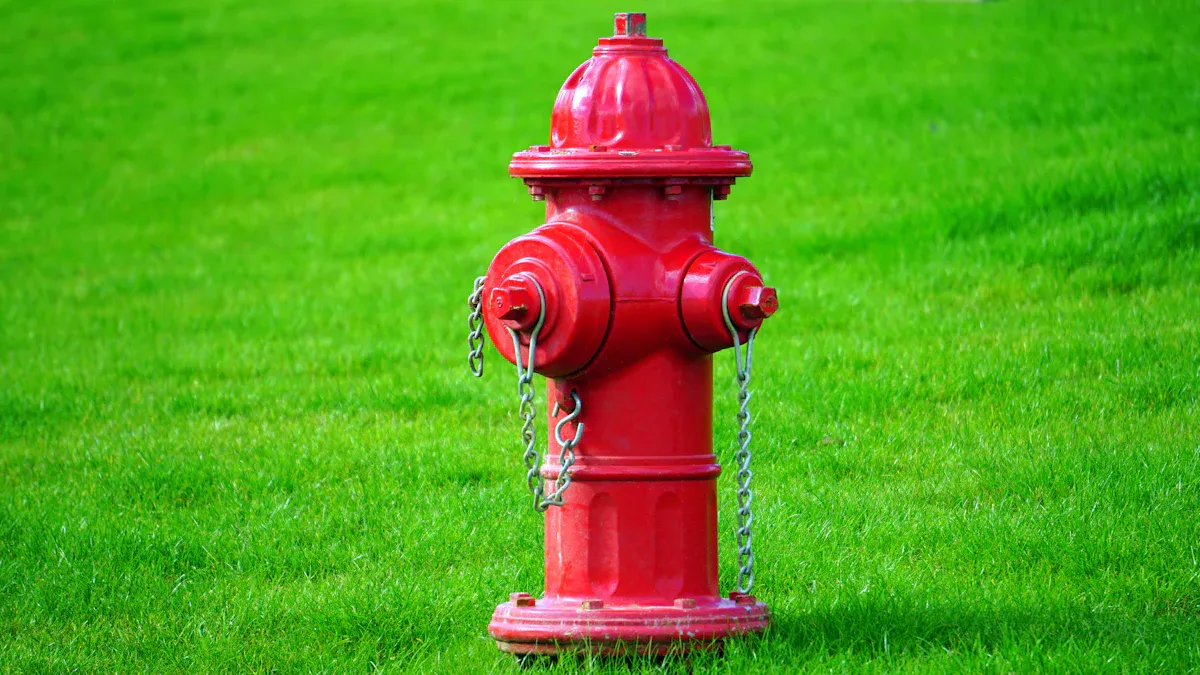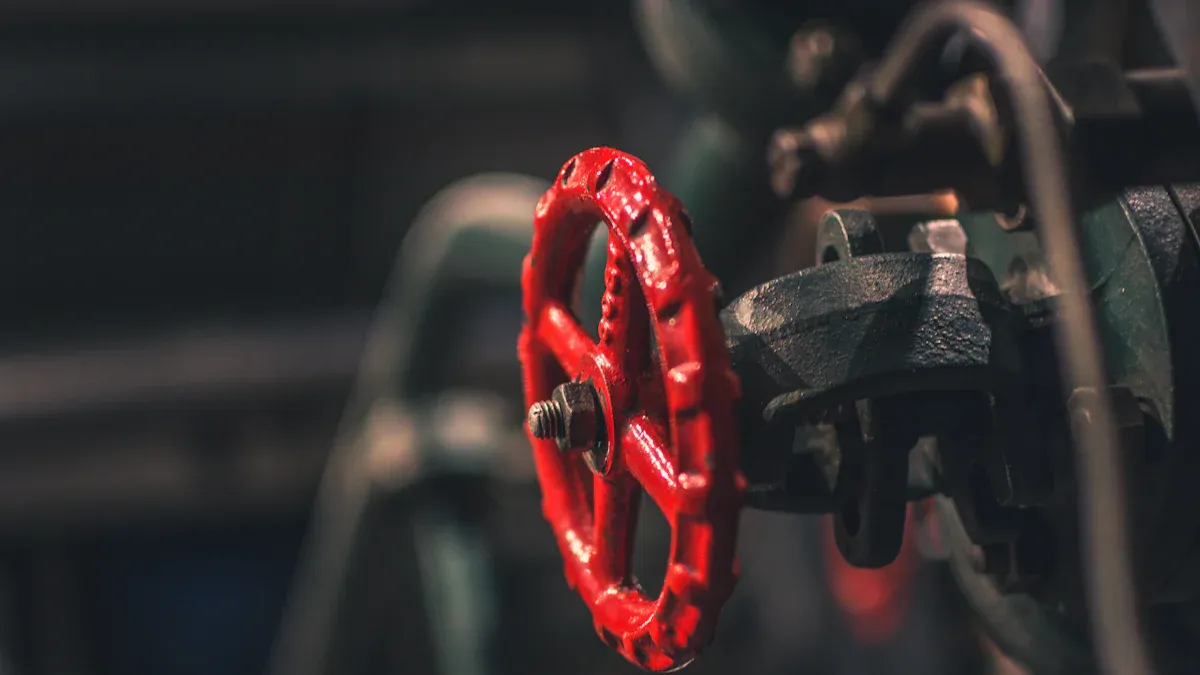
Maintaining a fire hydrant valve is critical to industrial safety. Neglecting maintenance can lead to serious risks, including system failures and emergency delays. For example, leaking water around the base or nozzle may indicate damage, causing pressure loss. Difficulty operating the valve often signals mechanical failure. Proactive care ensures reliable performance during emergencies.
Key Takeaways
- Checking fire hydrant valves often is very important. It helps find leaks or damage and keeps them ready for emergencies.
- Taking care of valves, like cleaning and oiling them, makes them last longer. This saves money on repairs and stops sudden problems.
- Using new software to plan and track work makes maintenance easier. These tools help follow safety rules and keep things working well.
Understanding Fire Hydrant Valves

Types of Fire Hydrant Valves
Fire hydrant valves come in various types, each designed to meet specific industrial needs. Common types include wet barrel valves, dry barrel valves, and pressure-regulating valves. Wet barrel valves are ideal for regions with mild climates, as they maintain water in the hydrant at all times. Dry barrel valves, on the other hand, are suited for colder areas where freezing temperatures could damage the system. Pressure-regulating valves ensure consistent water flow, even in high-pressure systems, making them essential for large-scale industrial facilities.
Selecting the right type of fire hydrant valve depends on factors such as climate, facility size, and water pressure requirements. Yuyao World Fire Fighting Equipment Factory offers a wide range of reliable fire hydrant valves tailored to diverse industrial applications.
Functions in Industrial Safety
Fire hydrant valves play a pivotal role in safeguarding industrial operations. They control water flow during emergencies, ensuring firefighters have access to a steady and reliable water supply. Properly functioning valves minimize response time, which is critical in preventing the spread of fires.
Statistical studies reveal that industrial fires cause an average annual damage of $1.2 billion in the U.S., with manufacturing facilities accounting for 30.5% of large-loss fires in 2022. This underscores the importance of effective fire safety equipment, including fire hydrant valves, in mitigating risks and protecting assets.
By maintaining operational readiness, fire hydrant valves contribute to compliance with safety regulations and reduce the likelihood of catastrophic losses. Their role extends beyond emergency response, as they also support routine fire drills and system testing, ensuring preparedness at all times.
Why Regular Maintenance is Crucial
Ensuring Safety and Operational Readiness
Regular maintenance of fire hydrant valves ensures their operational readiness during emergencies. Firefighting preparedness depends on adequate water flow and pressure, which only well-maintained valves can provide. Engineers rely on design information from flow testing to create efficient water systems tailored to industrial needs. Periodic inspections confirm flow rates, validating that existing systems meet their intended performance metrics. Regulatory compliance also benefits from routine maintenance, as it ensures adherence to standards and insurance requirements. Emergency response planning improves when maintenance identifies areas with insufficient water supply, enabling better resource allocation during crises.
| Metric | Description |
|---|---|
| Firefighting Preparedness | Ensures adequate water flow and pressure for effective firefighting operations. |
| Design Information | Provides essential data for engineers to design efficient water systems based on flow rates and pressure levels. |
| Confirming Flow Rates | Validates that designed flows are met in existing systems through real-world data. |
| Regulatory Compliance | Ensures adherence to standards and insurance requirements through periodic flow testing. |
| Emergency Response Planning | Identifies areas with insufficient water supply for better resource allocation during emergencies. |
Meeting Compliance Standards
Compliance with safety regulations requires accurate record-keeping and regular inspections. NFPA 291 standards emphasize flow testing and maintenance to ensure reliability. Municipalities use these records to track repairs and inspections, reducing the risk of non-compliance. Neglecting maintenance compromises public safety and exposes facilities to legal and financial penalties. Proactive management of fire hydrant valves safeguards operations and aligns with industry standards.
- Regular inspections and flow testing maintain reliability.
- Accurate record-keeping supports compliance with NFPA 291 standards.
- Neglecting maintenance risks public safety and non-compliance.
Reducing Costs and Preventing Downtime
Preventive maintenance reduces costs and minimizes downtime. A manufacturing plant implementing a maintenance program achieved a 30% reduction in unplanned downtime. Fleet management programs saved on emergency repairs and improved efficiency through regular inspections. Chemical plants adhering to strict schedules avoided environmental disasters and fines. These examples highlight the financial and operational benefits of proactive maintenance.
| Case Study | Description | Result |
|---|---|---|
| Manufacturing Plant | Implemented a preventive maintenance program for machinery. | 30% reduction in unplanned downtime. |
| Fleet Management | Maintained delivery trucks with regular oil changes and inspections. | Saved on emergency repairs and improved efficiency. |
| Chemical Plant | Adhered to strict maintenance schedules for safety systems. | Avoided environmental disasters and fines. |
Best Practices for Fire Hydrant Valve Maintenance
Inspecting for Wear, Damage, and Leaks
Regular inspections are essential to identify wear, damage, and leaks in fire hydrant valves. Hydrostatic testing evaluates the entire system, ensuring all risks are analyzed before testing begins. Compliance with NFPA 13 standards guarantees that inspections meet minimum requirements for design, installation, and maintenance.
| Inspection Method | Description |
|---|---|
| Hydrostatic Testing | Ensures a full system evaluation is completed and all risks analyzed. |
| NFPA 13 Compliance | Outlines minimum requirements for fire sprinkler system maintenance. |
Advanced technologies like acoustic sensors enhance inspection accuracy. These sensors measure sound wave travel time through pipes, revealing the condition of the pipe wall and detecting leaks without excavation. The ePulse condition assessment service uses this method to provide valuable data for maintenance decisions.
Cleaning to Remove Debris and Corrosion
Cleaning fire hydrant valves prevents debris buildup and corrosion, which can compromise functionality. Industrial environments often expose valves to harsh conditions, leading to rust and sediment accumulation. Routine cleaning ensures unobstructed water flow and extends the valve’s lifespan.
Technicians should use non-abrasive tools and cleaning agents to remove debris without damaging the valve’s surface. For heavily corroded valves, specialized treatments like chemical descaling may be necessary. Yuyao World Fire Fighting Equipment Factory offers durable fire hydrant valves designed to withstand industrial wear and tear, reducing the frequency of cleaning required.
Lubricating Moving Parts for Smooth Operation
Lubrication plays a vital role in maintaining the efficiency of fire hydrant valves. It reduces friction between moving parts, preventing wear and tear. Proper lubrication also improves sealing, ensuring the valve operates without leaks.
| Benefit of Lubrication | Explanation |
|---|---|
| Reduces friction | Minimizes wear and tear on moving parts. |
| Improves sealing | Enhances efficiency by preventing leaks. |
| Prevents sudden failures | Avoids unexpected breakdowns during emergencies. |
| Extends service life | Reduces repair costs by prolonging valve longevity. |
| Prevents stiffness and wear of the stem | Keeps the valve stem functional and damage-free. |
Technicians should apply high-quality lubricants to all moving parts during maintenance. Regular lubrication schedules ensure the valve remains operational and ready for emergencies.
Testing Performance and Pressure
Testing fire hydrant valves verifies their performance and ensures adequate water pressure for firefighting operations. NFPA 291 recommends maintaining a residual pressure of 20 psi for effective firefighting. Hydrant flow tests, conducted every five years, confirm the valve’s capacity and functionality.
The data collected during flow tests identifies issues like blockages or infrastructure problems within the water distribution system. This information aids in designing fire sprinkler systems that meet water supply requirements for fire suppression. Regular testing ensures valves remain reliable and compliant with safety standards.
Documenting Maintenance Activities
Accurate documentation is a cornerstone of effective fire hydrant valve maintenance. Records of inspections, cleaning, lubrication, and testing provide a clear history of the valve’s condition. These records support compliance with NFPA 25 and NFPA 13 regulations, reducing the risk of penalties.
Technicians should use software tools to streamline documentation. Digital platforms simplify record-keeping, allowing easy access to maintenance logs and inspection schedules. Yuyao World Fire Fighting Equipment Factory recommends adopting modern technologies to enhance efficiency and ensure compliance.
Tip: Keeping detailed records not only ensures regulatory compliance but also helps identify maintenance trends, enabling proactive decision-making.
Tools and Technologies for Effective Maintenance

Manual Tools for Inspection and Repair
Manual tools remain indispensable for maintaining fire hydrant valves. Spanner wrenches, for instance, play a critical role in ensuring the operational readiness of firefighting infrastructure. These tools allow technicians to quickly connect and disconnect hoses, which enhances the efficiency of emergency responses. Their ergonomic design minimizes risks during hose connections, promoting safety for personnel.
Routine maintenance tasks, such as inspections, cleaning, and component replacements, also rely heavily on manual tools. These tools ensure that valves remain functional and durable over time. By incorporating high-quality manual tools into maintenance routines, facilities can extend the lifespan of their equipment and reduce the likelihood of unexpected failures.
Software for Scheduling and Record-Keeping
Modern software solutions streamline the scheduling and record-keeping processes for fire hydrant valve maintenance. These tools optimize maintenance workflows by reducing paperwork and manual data entry. They also provide real-time visibility into task progress, ensuring transparency and accountability.
Key benefits of using software include:
- Seamless Scheduling: Efficiently allocates jobs and resources, reducing missed appointments.
- Task Tracking: Monitors progress in real-time, ensuring tasks are completed on schedule.
- Accurate Record Keeping: Centralizes maintenance records, simplifying audits and reporting.
By adopting these technologies, facilities can improve productivity and ensure compliance with safety standards. Software tools not only enhance operational efficiency but also help identify trends in maintenance activities, enabling proactive decision-making.
Advanced Diagnostic Equipment
Advanced diagnostic equipment has revolutionized fire hydrant valve maintenance. Predictive diagnostics, powered by open technologies, collect raw data from valve positioners and define key performance indicators (KPIs) for valve health. This data enables technicians to identify potential issues before they escalate, reducing downtime and repair costs.
Recent advancements include:
- A herbicide plant saved $230,000 annually by transitioning to predictive maintenance.
- A refinery avoided a $5.6M unplanned outage and saved $400,000 yearly through remote monitoring of critical valves.
- A combined cycle power plant saved $68,000 in one outage after upgrading digital valve controllers.
Cloud-based diagnostics further enhance maintenance capabilities by enabling remote monitoring and advanced analytics. These systems collect and analyze data from multiple devices simultaneously, allowing for early detection of issues. For example, valve data management packages like Fisher FIELDVUE ValveLink software provide continuous monitoring and automatic online testing. Future enhancements, including machine learning and AI, will further improve predictive maintenance, ensuring timely interventions and optimal valve performance.
Note: Investing in advanced diagnostic tools not only improves maintenance efficiency but also safeguards industrial operations against costly disruptions.
Avoiding Common Maintenance Mistakes
Skipping Routine Inspections
Routine inspections are the backbone of fire hydrant valve maintenance. Neglecting them can lead to undetected issues that compromise safety and functionality. For instance:
- A routine fire drill at an industrial facility uncovered a closed sprinkler valve, which could have caused a catastrophic failure during an actual emergency.
- In a high-rise fire, firefighters discovered that standpipe valves were closed, delaying water supply to upper floors. This oversight allowed the fire to spread, causing extensive damage.
These examples highlight the importance of regular inspections. Technicians should establish a consistent schedule to check for leaks, corrosion, and operational readiness. Missing even one inspection can result in costly consequences.
Using Incorrect Tools or Methods
Using improper tools or methods during maintenance can damage fire hydrant valves. For example, applying excessive force with the wrong wrench may strip threads or crack components. Technicians should always use manufacturer-recommended tools to avoid such risks.
Proper training is equally important. Maintenance personnel must understand the correct procedures for cleaning, lubrication, and testing. Adhering to best practices ensures the longevity and reliability of the equipment.
Ignoring Manufacturer Guidelines
Manufacturer guidelines provide critical information about the design and maintenance of fire hydrant valves. Ignoring these instructions can lead to improper repairs or adjustments. For example, using incompatible lubricants may degrade seals, causing leaks.
Technicians should consult the valve’s manual before performing any maintenance. Following these guidelines ensures compliance with safety standards and extends the valve’s service life.
Failing to Document Maintenance
Accurate documentation is essential for tracking maintenance activities. Without proper records, facilities risk non-compliance with safety regulations. Maintenance logs also help identify recurring issues, enabling proactive solutions.
Digital tools simplify this process. Software platforms allow technicians to record inspections, repairs, and tests efficiently. Facilities that prioritize documentation improve accountability and ensure operational readiness.
Tip: Consistent record-keeping not only supports compliance but also enhances decision-making for long-term maintenance planning.
Maintaining fire hydrant valves ensures industrial safety by preventing accidents, improving efficiency, and meeting regulatory standards. Regular inspections, cleaning, lubrication, and testing enhance reliability and operational readiness. Modern tools, such as smart valve positioners and diagnostic technologies, streamline maintenance processes. Yuyao World Fire Fighting Equipment Factory delivers durable solutions tailored to industrial needs, ensuring optimal performance.
FAQ
1. How often should fire hydrant valves be inspected?
Fire hydrant valves should be inspected quarterly to ensure operational readiness. Regular inspections prevent wear, leaks, and corrosion, safeguarding industrial safety during emergencies.
2. What tools are essential for fire hydrant valve maintenance?
Technicians need spanner wrenches, lubricants, and cleaning agents. Advanced diagnostic tools like acoustic sensors enhance accuracy and efficiency during inspections and repairs.
3. Can software improve maintenance scheduling?
Yes, software simplifies scheduling and record-keeping. It tracks tasks, ensures compliance, and provides real-time updates, optimizing workflows for industrial facilities.
Tip: Use software to centralize maintenance logs for easy audits and reporting.
Post time: May-15-2025

